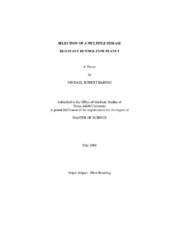| dc.description.abstract | Four F2:4 populations of peanut (Arachis hypogaea L.) resulting from the complex
cross Tamrun 96 X Tx901639-3 X Sun Oleic 95R were grown in three disease nurseries
over a 2 year period. Three separate selection techniques were applied to determine
which technique would provide the most effective method for selecting a multiple
disease resistant, runner-type peanut. Technique I involved selection at a tomato spotted
wilt virus nursery during the first cycle of selection and transferring the selections to a
Sclerotinia minor (Jagger) nursery for a second cycle of selection in year two.
Technique II was the reciprocal of Technique I. Technique III involved selection of the
populations at a multiple disease nursery for two consecutive years. Selections were
based on disease ratings, growth habits, pod and seed characteristics, and oleic/linoleic
acid ratios. Disease ratings were scored as percentage infection on a scale of 0 (0% plot
infected) to 10 (100% plot infected). Disease severity was also rated on a scale of 1
(symptoms noted, but no yield effects) to 10 (plant death, no yield). There were two
final selections for each population using each selection technique that were yield tested
over a 2 year period to determine which technique was superior. The yield tests were
conducted using completely randomized block design at all three disease nurseries with an additional disease-free site included. Data for disease ratings, yield, grade, and value
per hectare were combined within locations across years. All three selection techniques
provided lines with more disease resistance than the parents; however, there was no
difference detected between the effectiveness of the three techniques in terms of disease
resistance, yield, grade, or value per hectare. | en |


